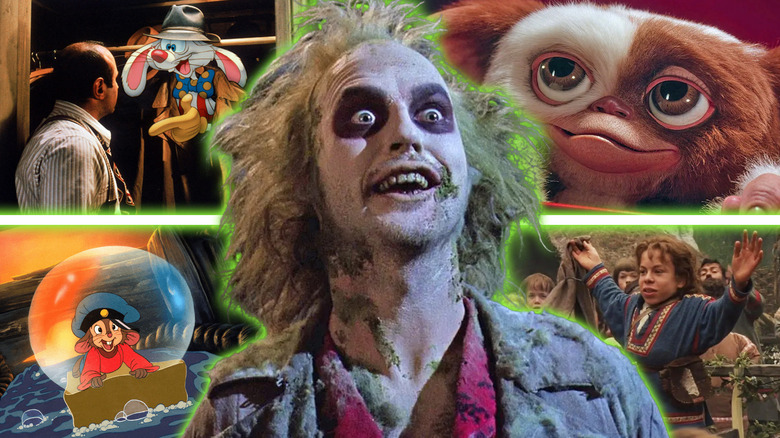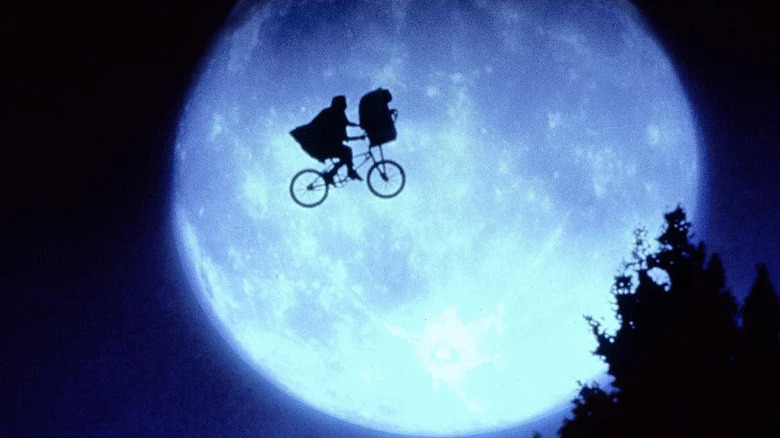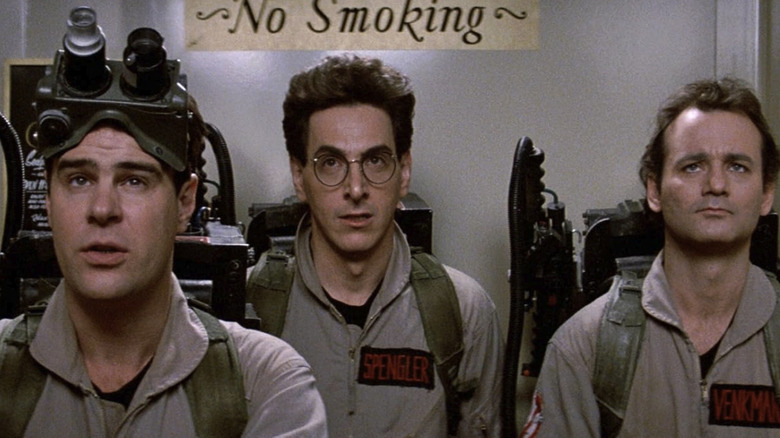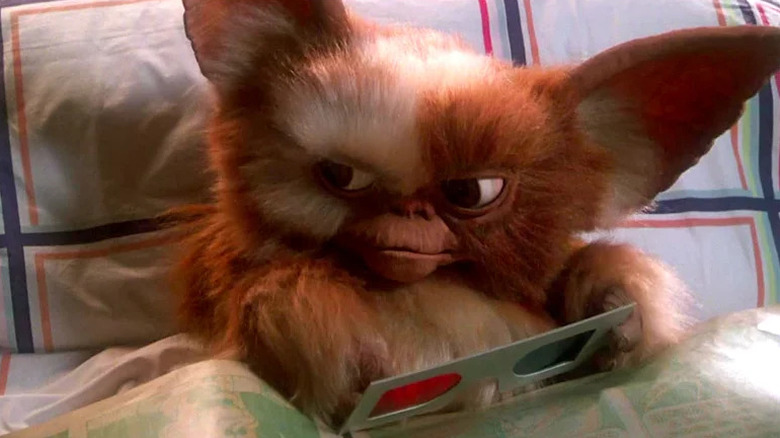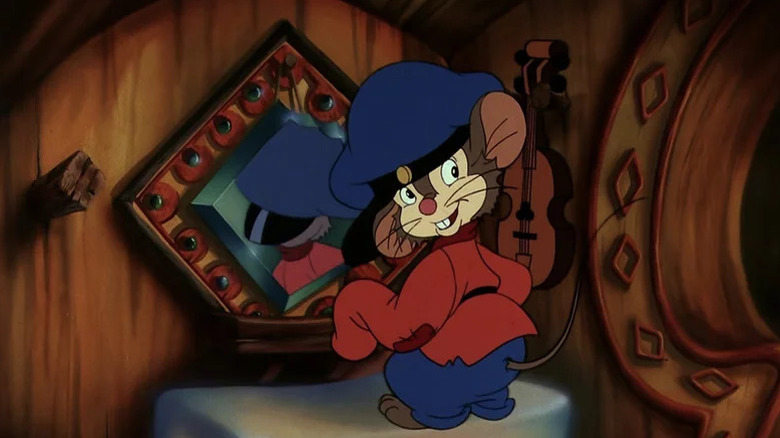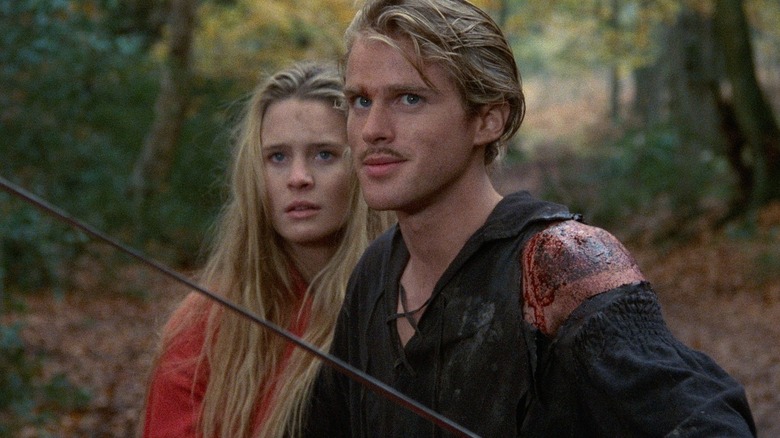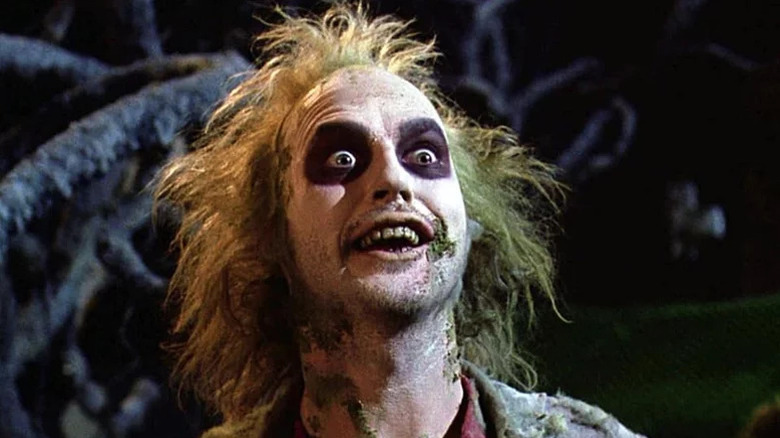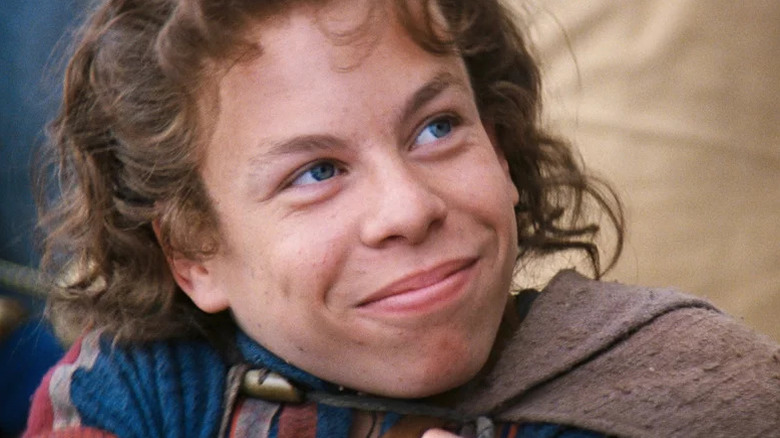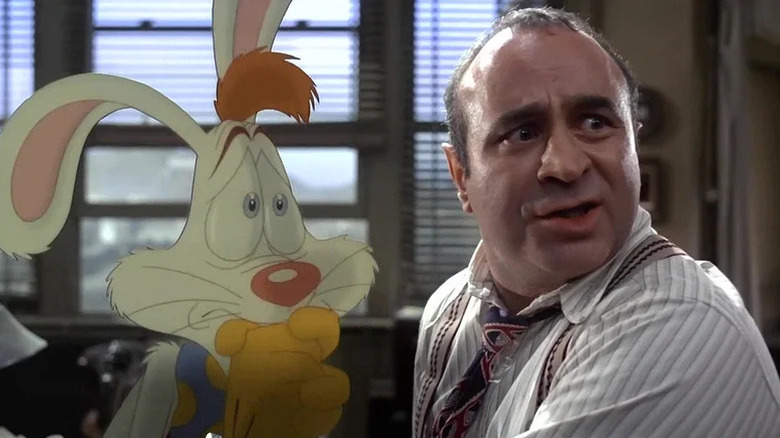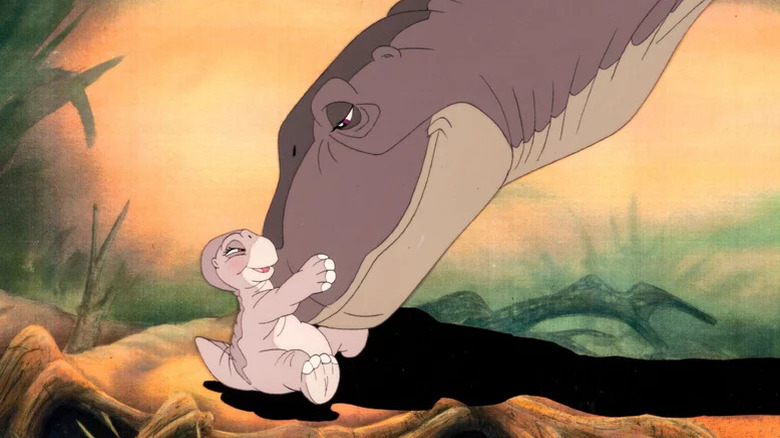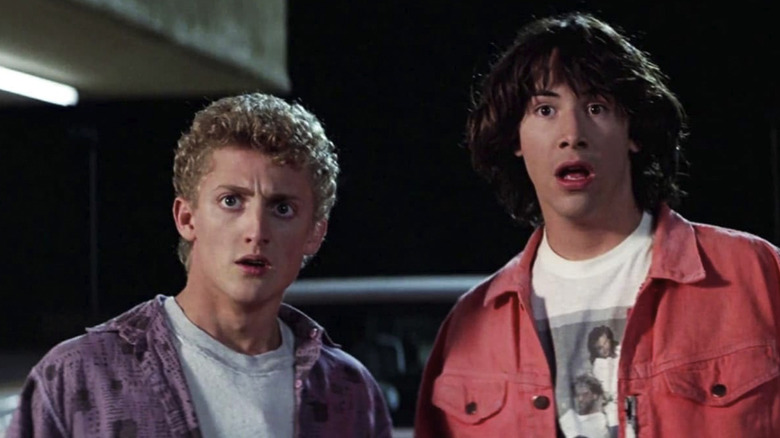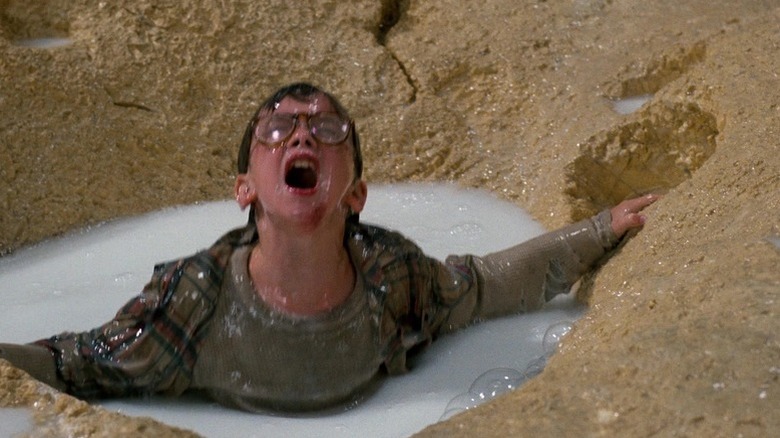'80s Kids Movies Everyone Needs To Watch At Least Once
While every decade has its own classic family-friendly movies, there is something about movies released in the '80s that just hits different. From the Amblin Entertainment projects that cemented Steven Spielberg's growing role in Hollywood to coming-of-age dramedies that defined the era, the '80s has no shortage of kids movies. At the same time, acclaimed animated movies expanded beyond just those produced by Walt Disney Animation Studios prior to its renaissance in the '90s. The '80s were great for children and adolescent movies, many of which still hold up decades later.
There are a handful of '80s kids movies that noticeably rise above the rest, standing among the best of their genre, no matter the target age group. And if you're trying to revisit that beloved decade or introduce viewers who missed its movies the first time around, these are the films that need to be seen and appreciated. Here are several '80s kids movies everyone needs to watch at least once, regardless of what decade in which they were born.
Raiders of the Lost Ark
While some might balk at "Raiders of the Lost Ark" being considered a kids movie, I'd at least make the argument that it's kid-appropriate, its gory climax notwithstanding. Filmmakers Steven Spielberg and George Lucas were inspired by the action-adventure movie serials of their youth when creating Indiana Jones, and those classic qualities are unmistakable. The first movie in the series remains the best, following Indy (Harrison Ford) as he tries to outrace the Nazis in recovering the biblical Ark of the Covenant. This reunites him with his old flame Marion Ravenwood (Karen Allen), and the two fight the Third Reich.
There are plenty of reasons why "Raiders of the Lost Ark" is the best Indiana Jones film, but a big one is its influences from Lucas and Spielberg. That action-adventure sense of wonder that both filmmakers grew up with is present in every major set piece in the movie, all masterfully staged. Ford arguably creates a more iconic character in Indy than he previously did with Han Solo, overtaking those movie serial archetypal heroes to make the role his own. For viewers that have outgrown the G and PG-rated fare, "Raiders of the Lost Ark" is the perfect step up.
E.T. the Extra-Terrestrial
For those who weren't around in the '80s, Steven Spielberg's "E.T. the Extra-Terrestrial" absolutely dominated pop culture upon its release in 1982. Set in a small California town, the titular visiting extraterrestrial is accidentally left by his spacefaring compatriots on Earth. Taking refuge in a suburban home, E.T. befriends a young boy named Elliott (Henry Thomas), forming a psychic bond with him. However, E.T.'s arrival hasn't gone unnoticed and Elliot tries to hide his otherworldly friend from government agents searching for him.
From its coming-of-age story of interstellar proportions to its soaring John Williams music, "E.T. the Extra-Terrestrial" is a near-perfect movie all around. So much of the story is told through the eyes of a child, which adds to its overall wonder, at its most apparent during the flying bike ride sequence. Interestingly, "E.T." was banned for children in Scandinavia over concerns that it was too intense, which seems more laughable now than it did back then. There's a strong argument that "E.T" is still Steven Spielberg's best movie, and it has the Rotten Tomatoes score to back that up.
Ghostbusters (1984)
As far as horror comedies go, it's hard to outdo the blend of humor and family-friendly appeal of 1984's "Ghostbusters." The movie follows three scientists in Manhattan who decide to go into business capturing ghosts with their experimental tech. Joined by hard-working everyman Winston Zeddemore (Ernie Hudson), the quartet finds business around the city surprisingly booming. However, the paranormal operation is threatened by heavy-handed EPA official Walter Peck (William Atherton), who is poised to shut down the Ghostbusters for good.
It's something that's widely taken for granted now, but filmmaker Ivan Reitman rewrote the rules of genre cinema with "Ghostbusters." The movie blended disparate genres in a way that hadn't been done to this level since "Abbott and Costello Meet Frankenstein." This is elevated by Bill Murray, Dan Aykroyd, and Harold Ramis each being at the height of their comedic powers and playing off of each other perfectly. With a couple good-natured scares and lots of laughs and paranormal action, "Ghostbusters" is a singular classic.
Gremlins
Another widely beloved horror comedy released on June 8, 1984, like "Ghostbusters," was Joe Dante's pint-sized creature feature "Gremlins." The movie sees Billy Peltzer (Zach Galligan) given an adorable mythical creature, known as a mogwai, for Christmas, naming his new pet Gizmo (Howie Mandel). However, when Gizmo is accidentally splashed with water, it spawns more mischievous mogwai, led by Stripe (Frank Welker), who transform into monstrously deadly gremlins if they eat after midnight. Billy and Gizmo, along with Billy's girlfriend Kate Beringer (Phoebe Cates), work together to save their town from the rampaging monsters.
Between "Ghostbusters" and "Gremlins," two stone-cold '80s classics ruled the box office at the same time, making June 1984 a watershed month in horror comedy. "Gremlins" is arguably the kid-friendlier movie of the two, but it was one of the classic movies that led to the creation of the PG-13 rating. The movie blends an effective Christmas atmosphere with plenty of monster-fueled mischief, subverting the holiday with its gleefully lethal creatures. A holiday horror comedy that isn't afraid to get scary and macabre, "Gremlins" is an '80s fan-favorite.
The Karate Kid
After directing the ultimate boxing movie with "Rocky," filmmaker John G. Avildsen brought those sensibilities to helming 1984's "The Karate Kid." The coming-of-age movie follows high schooler Daniel LaRusso (Ralph Macchio) as he relocates with his mother from New Jersey to Southern California. Daniel attracts the ire of bully Johnny Lawrence (William Zabka), who is trained in karate at the local Cobra Kai dojo. Daniel finds a martial arts mentor of his own in his apartment's handyman Mr. Miyagi (Pat Morita), who trains Daniel with unconventional but effective techniques.
With its killer soundtrack and teen drama elements, "The Karate Kid" is a strong '80s coming-of-age tale even without the martial arts. But it's Morita's performance, the revelation of his training strategy, and the movie's climactic tournament that propels it as an all-time classic. Macchio, along with co-stars Zabka and Elisabeth Shue, are a strong love triangle, making up the movie's emotional core that fuels the stakes and underlies every skirmish. The 1984 movie launched "The Karate Kid" franchise, including "Cobra Kai," and the foundations laid by this inciting film still hold up.
The Goonies
For those who might think "Raiders of the Lost Ark" is too intense for impressionable viewers, "The Goonies" definitely caters to a younger audience. The 1985 movie is set in Astoria, Oregon, with a group of kids discovering a treasure map directing them to a nearby 17th century pirate's stash. Realizing this treasure is their best chance at saving their homes from foreclosure, the ensemble ventures into a vast network of caves below the town to find the legendary loot. However, the gang not only encounters traps left to ward off treasure hunters, but are pursued closely by the Fratelli crime family.
"The Goonies" is the ultimate childhood action-adventure wish fulfillment story; every kid fantasizes about discovering an actual buried treasure. The main cast of juvenile misfits are fun and gel well together while the story feels just familiar enough to not seem incredibly outlandish. Decades after its debut, "The Goonies" became a streaming hit on HBO Max, cementing its status as one of the best adventure movies ever. While fans continue to hold out hope for a legacy sequel, the 1985 classic certainly holds up for modern audiences.
Back to the Future
Immediately regarded as a cross-generational classic, 1985's "Back to the Future" is the perfect coming-of-age sci-fi film. Protagonist Marty McFly (Michael J. Fox) accidentally drives a time-traveling DeLorean designed by his friend Doc Brown (Christopher Lloyd) to 1955. As Marty works with a younger Doc to find a way to return to his own time, he interrupts his parents' teenage coupling. In order to ensure that he and his siblings will be born, Marty works as a matchmaker to bring his eventual parents together.
"Back to the Future" sparked an everlasting cinematic legacy with its epic box office run, not even taking its sequels into account. To impressionable viewers, Marty still feels like the coolest high schooler on the block, skateboarding around town, punching bullies, and playing a mean guitar solo. The movie is still just innocent enough where it avoids any major cynicism, to the point where the sci-fi classic couldn't exist today, at least not in the same way. And whenever that Alan Silvestri theme kicks in, "Back to the Future" is sure to rouse viewers of any age as the DeLorean hits 88 miles per hour.
An American Tail
Former Disney animator Don Bluth opened his own animation studio in 1979 and began producing movies in the '80s. Teaming up with Steven Spielberg's Amblin Entertainment, Bluth's first big hit was 1985's "An American Tail," which he directed and produced. Set in 1885, Fievel Mousekewitz (Phillip Glasser) is a Russian-Jewish mouse who emigrates to America with his family after facing persecution in Europe. Arriving in New York, Fievel befriends other working-class mice as they stand up against corrupt and powerful figures exploiting impoverished and vulnerable communities in the city.
A recurring theme in every single Don Bluth movie is the idea of its characters trying to find home in the wider world. "An American Tail" illustrates this concept better than the rest of Bluth's work, framed amid the classic backdrop of the American Dream. Bluth's movies featured a bit more grit than their Disney-produced contemporaries, but unlike "The Secret of NIMH," didn't feel overly dark and violent. That distinction makes "An American Tail" more grounded, yet accessible, giving the animated film a real family-friendly warmth.
The Princess Bride
Filmmaker Rob Reiner was a fan of William Goldman's 1973 fantasy novel "The Princess Bride" and directed and produced its adaptation in 1987, with Goldman himself writing the screenplay. The fairy tale follows Princess Buttercup (Robin Wright), who is separated from her beloved Westley (Cary Elwes) and forced into an engagement with the cruel Prince Humperdinck (Chris Sarandon). Humperdinck captures the reunited couple, intending to murder Westley and proceed with his plans to marry Buttercup. Escaping from custody only mostly dead, Westley and his new allies storm the castle to interrupt the wedding and rescue Buttercup from her unhappy betrothal.
Given its celebrated status as the definitive modern fairy tale, it's inconceivable if you haven't watched "The Princess Bride" already. If the medieval fantasy movie has somehow eluded you so far, it lives up to its reputation thank to its numerous quotable scenes and memorable ensemble cast. The movie endures because of its earnest and accessible nature, lacking any discernibly cynical bones in its cinematic body. An absolute treat and the perfect way to while away a sick day, "The Princess Bride" is Reiner's fantasy masterpiece.
Beetlejuice
Quirky filmmaker Tim Burton's career catapulted to the upper echelon in the '80s, elevated by movies like the 1988 horror comedy "Beetlejuice." The movie opens with married couple Adam (Alec Baldwin) and Barbara Maitland (Geena Davis) dying in a tragic accident. Rising as ghosts, the two are shocked that their marital home is now occupied by the obnoxious Deetz family. Determined to reclaim the house, the post-mortem pair hire the mischievous spirit Betelgeuse (Michael Keaton) to scare out the family, only to receive more than they bargained for.
Like many of Burton's movies, "Beetlejuice" is a bizarre film, even more than flicks like "Edward Scissorhands" or "The Corpse Bride." Given the premise, the movie is certainly macabre, but it's always played for laughs, with its visual effects underscoring that the movie is something of a live-action cartoon. The fright-fueled antics are presented like slapstick gags and Keaton plays Betelgeuse like a mean-spirited washed-up comedian to great effect. Though he may have had bigger financial successes later, "Beetlejuice" is the box office hit that defined Tim Burton's career.
Willow
In between producing Indiana Jones movies, Lucasfilm ventured into high fantasy with its 1988 movie "Willow," based on a story by George Lucas. The movie has evil Queen Bavmorda (Jean Marsh) hunt the realm for an infant prophesied to cause her downfall. The child comes into the care of aspiring dwarf sorcerer Willow Ufgood (Warwick Davis), who agrees to escort her back to her family. As Willow confronts Bavmorda's forces, he teams up with a mercenary named Madmartigan (Val Kilmer) and other quirky figures to thwart the sinister queen's plot.
Decades later, "Willow" remains a charming and empowering fantasy tale that gets by considerably on the strength of its cast. The movie was the most ambitious that filmmaker Ron Howard had directed at that time, and he rose to the challenge admirably. Davis brings a wide-eyed earnestness to his performance as Willow while Kilmer was never more rascally dashing as Madmartigan. Another fairy tale crafted for modern sensibilities, "Willow" remains the most underrated Lucasfilm '80s production.
Who Framed Roger Rabbit
Filmmaker Robert Zemeckis has always had a knack for incorporating advancing technologies into his movies, especially when it came to 1988's "Who Framed Roger Rabbit." The movie takes place in a 1940s Hollywood where cartoons are actual living individuals residing in a city known as Toontown. Private investigator Eddie Valentine (Bob Hoskins) reluctantly agrees to help beloved toon Roger Rabbit (Charles Fleischer) clear his name when he's suspected of murdering a powerful studio head. This leads to a wider conspiracy which happens to connect to the shadowy toon that killed Eddie's brother, a murder that left Eddie contemptuous of toons.
On multiple levels, "Who Framed Roger Rabbit" still works like gangbusters decades after its initial release. On one hand, it's an effective send-up of neo-noir stories during Hollywood's Golden Age, and on the other, it's a love letter to the classic cartoons of its era. A big part of selling the ridiculous premise's verisimilitude is its lead, with Bob Hoskins essentially inventing the modern blockbuster performance by playing his part relatively straightforwardly. Hoskins anchors the movie even as Eddie is surrounded by cartoonish villains, Donald and Daffy Duck engaging in a piano duel, and Toontown itself, and the result is unforgettable.
The Land Before Time
Animator Don Bluth topped his own "An American Tail" success with 1988's "The Land Before Time." Set during the prehistoric era, the movie has a young apatosaurus named Littlefoot (Gabriel Damon) search for a bountiful oasis as the region faces a great famine. Following the death of his mother (Helen Shaver) after a battle against a T-Rex, Littlefoot is joined by several other young dinosaurs in his journey. As the group nears the purported Great Valley, they are pursued by the T-Rex, who survived the earlier skirmish.
"The Land Before Time" is, broadly speaking, a prehistoric riff on the themes of "Bambi," with the human hunter replaced by a carnivorous predator. Littlefoot overcomes parental loss, makes interspecies friends, and finds a safe haven, with those familiar narrative beats resonating just as strongly here as they did in the Disney film. The movie is darker and more emotionally stirring than Bluth's previous efforts, which is saying something; the original version was way too scary for kids. This quixotic blend of narrative elements, along with the primal appeal of dinosaurs, makes "The Land Before Time" Bluth's best '80s movie.
Bill & Ted's Excellent Adventure
Long before he became a global action movie icon, Keanu Reeves catapulted into the Hollywood mainstream through his comedic projects. More specifically, Reeves' starring role alongside Alex Winter in 1989's "Bill & Ted's Excellent Adventure" put him into the spotlight. The movie follows Bill Preston (Winter) and Ted Logan (Reeves), two high schoolers more interested in rocking out than getting good grades. The duo is whisked through time by Rufus (George Carlin), who informs them that his utopian future is dependent on both buddies passing a crucial history presentation.
"Excellent Adventure" remains the best of the three "Bill & Ted" movies, largely thanks to its "magical mystery tour through time" premise. There's a goofy innocence that Winter and Reeves bring to their characters amidst their time-bending journey that consistently makes the humor work, and a big factor in this appeal is that the casting was a throwback to Laurel & Hardy and other classic comedy teams, giving the laughs a timeless quality. Bill and Ted would reunite for sequels and an animated spin-off, but the 1988 original manages the balance between teen comedy and its sci-fi stakes the best.
Honey, I Shrunk the Kids
The '80s were a particularly popular decade for Canadian comic actor Rick Moranis, and that included starring in 1989's "Honey, I Shrunk the Kids." Moranis plays Wayne Szalinski, a looney scientist who invents advanced contraptions that actually work. This includes a shrinking ray, which accidentally miniaturizes Wayne's children and their friends to become smaller than ants. Stranded outside of the house, the kids must make the epic journey through the yard back to the shrinking ray to restore their size, braving household perils along the way.
At its core, "Honey, I Shrunk the Kids" is a funnier and more family-friendly version of pulp '50s sci-fi movies like "The Incredible Shrinking Man." A big part of the movie's charm is that, despite its big studio backing, this is a B-movie at heart and it embraces those tropes. Through their arduous trek back to the shrinking machine, the kids learn a lot, striking up teenage romance while facing death firsthand, but still maintaining kids movie sensibilities. The biggest Rick Moranis role before he disappeared from Hollywood, "Honey, I Shrunk the Kids" helped close out the '80s in style.
